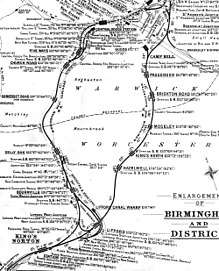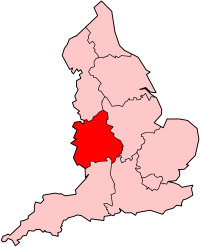Camp Hill Line
| Camp Hill Line | |
|---|---|
| Overview | |
| Type | Heavy rail |
| System | National Rail |
| Status | Operational |
| Locale | Birmingham |
| Termini |
Birmingham New Street Kings Norton |
| Stations | 0/6 |
| Operation | |
| Opened | 1840-41 |
| Owner | Network Rail |
| Operator(s) |
CrossCountry West Midlands Trains |
| Rolling stock |
Class 150 Class 170 "Turbostar" Class 172 "Turbostar" Class 220 "Voyager" Class 221 "Super Voyager" |
| Technical | |
| Number of tracks | 2 |
| Track gauge | 4 ft 8 1⁄2 in (1,435 mm) standard gauge |
The Camp Hill line is a railway line in Birmingham which lies between Kings Norton on the Cross-City Line and Birmingham New Street via Grand Junction on the main lines from Derby and Coventry.
Local passenger services on the line were ended in the 1940s, and the intermediate stations on the line were closed, since then it has been used by freight trains and some longer distance passenger trains only. There are currently plans to restore local services to the line via new chords connecting the line to Birmingham Moor Street.
History
What is now the Camp Hill Line originated as part of the Birmingham and Gloucester Railway (B&GR) which was opened from Gloucester to a temporary terminus at Camp Hill in December 1840, in August the following year the line was extended into Curzon Street the then main station in Birmingham; with the original Camp Hill terminus becoming a goods station, which it remained until 1966. The terminus later switched from Curzon Street to Birmingham New Street station in 1854.[1] The B&GR itself was taken over by the Midland Railway in 1845.[2]

In 1861 a Junction was constructed at Bordesley, creating a north to south-east connection from the Camp Hill Line to the Great Western Railway's main line to Oxford and London (now known as the Chiltern Main Line) which remains in use, and allows trains from Oxford and beyond to run into Birmingham New Street via the Camp Hill Line.[3]
In 1864 a 'direct' line was opened between St Andrews and Landor Street Junctions at the north end of the Camp Hill Line, connecting it to the Midland Railway's line to Derby. From this date Midland expresses from Derby to Bristol ran via this route to Camp Hill, where portions of the train bound for Birmingham New Street would be detached or attached from the train. As both the Midland Railway lines from Derby and Bristol approached New Street from the east, this arrangement avoided the need for them to reverse at New Street. This arrangement persisted until 1885 when the Birmingham West Suburban Railway (BWSR) was extended into New Street from the west, allowing Derby to Bristol trains to run directly through New Street and rejoin the B&GR route at Kings Norton railway station.[4]
In 1892 the Lifford curve opened creating a north facing connection between the Camp Hill Line and the Birmingham West Suburban Railway, this allowed a circular service to operate from New Street via the Camp Hill Line and returning via the BWSR. Local passenger services on the Camp Hill Line were suspended in 1941 as a 'wartime economy' which was confirmed as permanent in 1946. Since then the line has been used by freight trains and some longer distance passenger trains only.[4]
Seven railway stations along the line were closed in 1941 and have been demolished; they are:
Future plans
The reinstatement of local rail services to the former Camp Hill Line has been a long term aspiration of the City,[5] and during 2007, Birmingham City Council announced that they were looking into the possibility of reopening the line between Kings Norton and Birmingham Moor Street via the construction of a railway viaduct from Sparkbrook to Bordesley, where trains would be taken into the "old" Birmingham Moor Street station. In October 2007, a 1500-name petition was handed in to the council asking for the line to be re-opened.[6] In 2013 the proposal was shelved indefinitely.[7]
The 2007 proposed station sites were:
In 2016, the newly created West Midlands Combined Authority revived the plans to restore local passenger services to the line, and declared it one of their priority transport schemes to be delivered by 2025.[8][9]
In 2017, the newly elected Mayor of the West Midlands Andy Street pledged to get work started on restoring services to the line by 2020. And officials were said to be investigating the business case for a fourth station at Balsall Heath (previously called Brighton Road).[10] This would mean Lifford and Camp Hill would be the only stations not to be reopened.
In August 2017, West Midlands Trains announced plans as part of their franchise deal that the line would reopen by December 2019 as part of a £1 billion investment in the West Midlands. This included a new station at Moseley.[11]
In February 2018, Mayor of the West Midlands, Andy Street, said that the viaduct would not be needed, as Hereford to Birmingham New Street trains could be diverted along this line, meaning that extra capacity at Birmingham New Street was not required to open this line. [12]
In July 2018, the Midlands Rail Hub was unveiled which would see reopening of Moseley, Kings Heath and Hazelwell with the chords built to connect Birmingham Moor Street with the line to Kings Norton and another to Water Orton.[13]
In September 2018, the designs of the new stations were revealed as Kings Heath, Hazelwell and Moseley were planned for reopening by 2021 with a frequency of 2 trains per hour. [14]
References
- ↑ Christiansen 1983, p. 55.
- ↑ Christiansen 1983, p. 56.
- ↑ "Bordesley Junction - Exchange Branch". Warwickshire Railways. Retrieved 14 January 2018.
- 1 2 Christiansen 1983, pp. 59-61.
- ↑ "Reinstatement of Camp Hill Rail Services Moves A Step Closer". Birmingham City Council. 2007-07-13. Archived from the original on 2008-01-11. Retrieved 2008-02-04.
- ↑ "Camp Hill railway petition delivered". Birmingham Post. 2007-10-11. Retrieved 2008-02-04.
- ↑ Council shunt Moseley and Kings Heath railway stations into the sidings
- ↑ "Could Moseley to Birmingham trains return to end commuter hell?". Birmingham Mail. 9 June 2016. Retrieved 20 July 2016.
- ↑ "£4Bn West Midlands transport boost unveiled by council leaders". The Chamberlain Files. 15 June 2016. Retrieved 20 July 2016.
- ↑ "This Birmingham train station is set for a revival". Birmingham Mail. Retrieved 6 July 2017.
- ↑
- ↑
- ↑
- ↑
Bibliography
- Christiansen, Rex (1983). A Regional History of the Railways of Great Britain, Volume 7 The West Midlands. David St John Thomas David & Charles. ISBN 0-946537-00-3.
- Boynton, John (1993). Rails Across The City, The Story of The Birmingham Cross City Line. Kidderminster: Mid England Books. ISBN 0-9522248-0-1.
External links
| Wikimedia Commons has media related to Camp Hill Line. |
- Birmingham City Council Camp Hill Railway Line Study Public Report, July 2007
- Birmingham City Council Detailed map of the proposed railway chord linking the Camp Hill line into Moor Street Station
